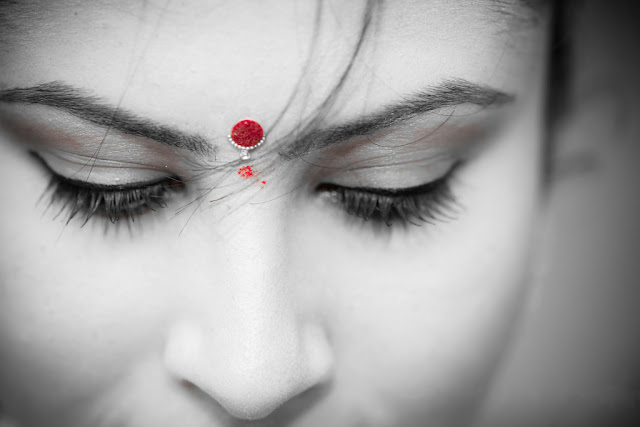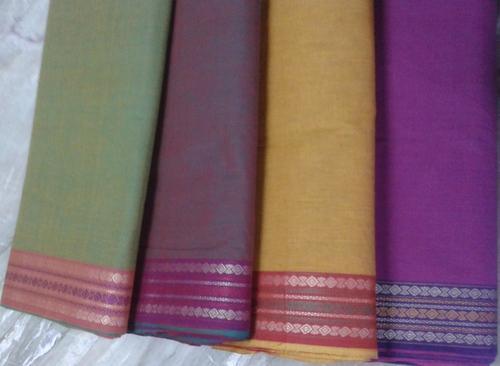16 Shringar or adornment is basically done for happiness and
prosperity in home. If done right with
purity and divine essence, it becomes the carrier of Love and Non – violence
and thus spreading Love and Placidity in society.
That is the reason why 16 shringar has been considered an important part of
Indian culture. Rig Vedas has
description of good luck that comes from 16 shringar. Let us see what those 16
shringars are :
1. Bindi
“Bindi” word is originated from
Sanskrit language. Bindi is usually “Kumkum” placed as a dot between the eyebrows on forehead, resembles
the third eye of “Shiva”. Many married women consider important to wear bindi.
It is believed to be reason or the prosperity in home.
2. Sindoor
In the northern part of India,
almost everywhere, “Sindoor” resembles “Suhag” or Husband. Sindoor ceremony is
very famous and integral part of Indian marriages when a groom puts Sindoor in
brides “Maang” or parting in hairs. From this day bride puts Sindoor in her Manng
every day.
3. Kajal
Known as Kohl or even eye - liner in English is a
must for Shringar. Besides it adds up to the beauty, it also protects bride and
her family from evil eye.
4. Mehandi
Without “Mehandi” or Henna
Shringar is never said to be complete.
Before a marriage in India all the females of both groom’s and bride’s family
apply Henna on their hands and legs. It is also said that darker the color of
henna is, more is bride loved by her groom.
5. Shadi ka Joda
North Indian brides usually wear
a “Joda” which contains “Ghagra” (Skirt), “Choli” (Midriff – baring blouse) and
“Odhni” (Stole) which is generally decorated with Zari. Similarly in East India
and Bihar, Bride wears Red and Yellow color Saree. In Maharashtra green color is considered auspicious during marriages.
6. Gajra
“Gajra” are made by sweet scented
flowers by knitting like garland and is worn on hair knot. It is prominently
used in southern part of India. These women generally use Night Jasmine flowers for
Gajra.
7. Mangtika
“Mangtika” is made of gold is and
placed on the parting of hair where Sindoor is applied. Besides adding up to
the beauty it is said that it reminds bride to follow the right and straight
path and to take decisions impartially.
8. Nath
Nath” or Nose ring is
worn by bride after “Saat Phere” in which both bride and groom take 7 rounds of
fire. It is worn to respect “Devi Parvati”. It is also believed to enhance the
Health and well – being of husband. North Indian woman wear nose ring on the
left side of the nose though south Indian women also wear ring in the middle
partition of the nose.
Nath is usually large in size and
thus uncomfortable to wear every day. That is why women usually wear it on
special occasion only. Most women replace it with a smaller ring for everyday
use or one can also use nose pin if not ring.
9. Jhumka
“Jhumka”, also known
as Ear – ring is of infinite styles though the basic idea behind many designs
is to use a chain to hold a beautiful shaped ornament entirely made of gold. It
is important for a married woman to wear Ear – rings after marriage. It is said
that this Jhumka is to remind bride to avoid listening to ill – talks about
husband and his family.
10. Haar
Haar” or also known
as Garland is made up of gold or pearl and it resembles the commitment of a
women to her husband. It is also said that this garland helps to maintain
health as there are some pressure points around neck. For this purpose garland
is made of gold instead of flowers and thus given a beautiful shape to be an integral part of Shringar.
“Mangalsutra” is also used as a
replacement of Haar since it is thinner than and good for daily usage.
11. Bajuband
“Bajuband” or Armlets is
generally made up of gold or silver. Women wear it tightly on biceps. Earlier
in Indian culture it was necessary for women to wear Bajuband and was believed
that by doing so husband’s wealth is preserved. It also resembles the victory
of good over evil.
12. Churi and Kangan
“Kangan” or Gold bracelet or
Bangles resembles the marriage of a woman since 18th century. In Hindu culture, in a ceremony called “Muh Dikhai” mother in law gives the
same bracelet to bride, which was given to her by her mother in law and is carried as a family tradition. Even today
many women still possess the bracelet given to them by their mother in law and
are waiting to give it to their daughter in law with the blessings of happiness
and good luck. Design and decorations on these gold bracelets varies from
region to region in India. Some women wear open ended bracelets while many
others wear closed ended bracelets.
A married Indian woman is never
said to keep her wrists empty or without “Churi” which is again a bracelet
usually made of glass or fiber. Churi are available in infinite colors and
each color is said to have different meanings or to be worn on different
occasions. For example red color is
dominating at the time of marriage (and months after that) and it shows that
bride is happy and satisfied with the
new relation. For the celebration of holi women usually use yellow color and to
celebrate “Teej”, green is preferred colour. Earlier many women wrapped the
corner of saree on wrists while changing Churi so that their wrist is not empty
for even a second while their husband is still alive.
13. Anguthi
Anguthi” or ring is
primarily exchanged between bride and groom before marriage at a function
called “Sagai” or engagement. Ancient Ramayan has also an incident related to
ring. When Ravna took Sita to Ashok Vatika after kidnapping her, she sent her
ring to Ram with the help of Hanuman. She sent her ring to Ram as a memory of
their relationship.
14. Kamarband
“Kamarband” is a bracelet to be
worn around waist after marriage. It adds up to the beauty of women.
It has usually a ring attached to it for keys and is made of gold or silver. A
woman wearing a Kamarband shows that she is the one who manages the whole
family and home.
15. Angutha and Bichua
It is basically a ring to be worn
in the fingers of leg. “Angutha” is to worn on the thumb and “Bichua” is to be
worn on fingers.Earlier these Angutha and Bichua were embedded with a very
small mirror. When woman was blushing and could not see her husband eye to
eye, she used to see her husband’s image in that mirror. Not just the husband
but earlier when woman were not allowed to see elders directly, this mirror
used to come handy in watching the person talking to.
Bichua is worn on 3 fingers of
leg except the smallest one. During marriage bichua is gifted to a woman by her
sister in law. This resembles that the bride will face all the forthcoming
challenges with courage and honour.
16. Payal
“Payal” or anklet has small bells
attached to it which signals the coming newly wedded bride in home. Earlier
elderly men used to give way to bride as soon as they heard the sound of bells
in anklet.
Interesting fact of Payal is that
earlier when child marriage was prominent, newly wedded woman was made to wear
Payal with lot of bells. The reason was that whenever bride was nostalgic about
her home, many bride used to run away to her home, thus the sound of bells will
indicate the movement of bride in whole house.
Payal is made by silver because
in hindu culture gold is considered auspicious since many god wear golden
crown. It is also believed that by wearing gold in legs one disrespects their
god.




































